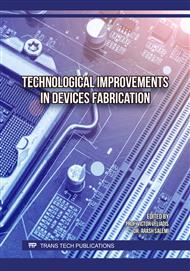[1]
A. Agarwal and B. J. Baliga, "Optimization of linear cell 4H-SiC power JBSFETs: Impact of N+ source contact resistance," Power Electronic Devices and Components, vol. 2, p.100008, (2022)
DOI: 10.1016/j.pedc.2022.100008
Google Scholar
[2]
H. Yu et al., "Titanium (germano-)silicides featuring 10−9 Ω·cm2 contact resistivity and improved compatibility to advanced CMOS technology," 2018 18th International Workshop on Junction Technology (IWJT), Shanghai, China, pp.1-5, (2018)
DOI: 10.1109/iwjt.2018.8330298
Google Scholar
[3]
A. Benhaya, F. Djeffal, K. Kacha, H. Ferhati, and A. Bendjerad, "Role of ITO ultra-thin layer in improving electrical performance and thermal reliability of Au/ITO/Si/Au structure: An experimental investigation," Superlattices and Microstructures, vol. 120, p.419–426, (2018)
DOI: 10.1016/j.spmi.2018.06.002
Google Scholar
[4]
A. Hannan et al., "The Effect of Nitrogen Plasma Treatment Process on Ohmic Contact Formation to N-Type 4H-SiC," Diffusion and defect data, solid state data. Part B, Solid state phenomena/Solid state phenomena, vol. 359, p.59–63, (2024)
DOI: 10.4028/p-fpu9au
Google Scholar
[5]
F. Roccaforte, F. La Via, and V. Raineri, "Ohmic Contacts to SiC," International Journal of High-Speed Electronics and Systems, vol. 15, no. 04, p.781–820, (2005)
DOI: 10.1142/s0129156405003429
Google Scholar
[6]
R. Kakanakov, L. Kassamakova-Kolaklieva, N. Hristeva, G. Lepoeva and K. Zekentes, "Thermally stable low resistivity ohmic contacts for high power and high temperature SiC device applications," 2002 23rd International Conference on Microelectronics, pp.205-208 vol.1, (2002)
DOI: 10.1109/miel.2002.1003175
Google Scholar
[7]
W. Lu, W. E. Collins, and W. C. Mitchel, "Material Selection and Interfacial Reaction in Ohmic-Contact Formation on SiC," Springer series in materials science, p.303–343, (2024)
DOI: 10.1007/978-3-662-09877-6_8
Google Scholar
[8]
S. Tanimoto and Hiromichi Oohashi, "High-Temperature Reliable Ni2Si-Based Contacts on SiC Connected to Si-Doped Al Interconnect via Ta/TaN Barrier," Materials science forum, vol. 615–617, p.561–564, (2009)
DOI: 10.4028/www.scientific.net/msf.615-617.561
Google Scholar
[9]
B.-Y. Tsui and J.-C. Cheng, "Effect of Ion-Implantation Temperature on Contact Resistance of Metal/n-Type 4H-SiC with Ar Plasma Treatment," IEEE Transactions on Electron Devices, vol. 66, no. 3, p.1464–1467, (2019)
DOI: 10.1109/ted.2019.2893187
Google Scholar
[10]
J. Meier, N. Achtziger, T. Licht, M. Uhrmacher, and W. Witthuhn, "Annealing behaviour of In impurities in SiC after ion implantation," Physica B: Condensed Matter, vol. 185, no. 1–4, p.207–210, (1993)
DOI: 10.1016/0921-4526(93)90238-2
Google Scholar


